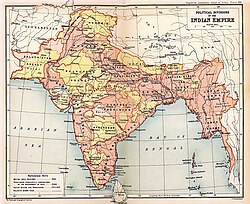இந்தியப் பஞ்சம், 1896–97
இந்தியப் பஞ்சம், 1896–97 (Indian famine of 1896–1897) பிரித்தானிய இந்தியாவின் வடக்கு மற்றும் நடுப்பகுதிகளைப் பிடித்த ஒரு பெரும் பஞ்சமாகும். 1896 இல் புந்தேல்கண்ட் என்னும் இடத்தில் தொடங்கி பின்பு ஐக்கிய மாகாணங்கள், மத்திய மாகாணங்கள் பேரர், பீகார், மும்பை மற்றும் சென்னை மாகாணங்களில் சில பகுதிகள் ஆகிய இடங்களுக்கும் பரவியது. இவை தவிர இராஜபுதனம், மத்திய இந்திய முகமை, ஐதராபாத் இராச்சியம் போன்ற மன்னர் அரசுகளுக்கும் (சமஸ்தானங்கள்) பரவியது. இரு ஆண்டுகளில் எட்டு லட்சம் சதுர கிமீ பரப்புள்ள பகுதிகளையும் 6.95 கோடி மக்களையும் பாதித்தது. இப்பஞ்சத்தை சமாளிக்க 1883 ஆம் ஆண்டு உருவாக்கப்பட்ட தற்காலிகப் பஞ்ச விதிகளின் படி பெரிய அளவில் பிரித்தானிய அரசு நிவாரணப் பணிகளை மேற்கொண்டது. எனினும் பட்டினி, தொற்று நோய்கள் ஆகியவற்றால் பாதிக்கப்பட்டு சுமார் 10 லட்சம் மக்கள் மடிந்தனர்.
| இந்தியப் பஞ்சம் 1896–97 Indian famine of 1896–1897 | |
|---|---|
 | |
| நாடு | பிரித்தானிய இந்தியாவில் மன்னர் அரசு நிலப்பரப்புகளான, இராஜபுதனம், மத்திய இந்திய முகமை, மற்றும் ஐதராபாத் |
| காலம் | 1896 – 1897 |
| காரணங்கள் | வறட்சி |
| மொத்த இறப்புகள் | 11 இலட்சம் |

ஆக்ரா மாகாணத்தின் புந்தேல்கண்ட் மாவட்டத்தில் 1895 ஆம் ஆண்டு கோடைக்காலப் பருவ மழை பொய்த்ததால் வறட்சி நிலவியது. குளிர்காலப் பருவமழையும் தவறியதால் மாவட்ட நிருவாகம் பஞ்ச நிவாரணப் பணிகளைத் தொடங்கியது. ஆனால் அடுத்த ஆண்டும் கோடைக்கால பருவ மழை தவறியது. பஞ்சம் பிரித்தானிய இந்தியாவின் பிற பகுதிகளுக்கும் பரவியது. 1883 பஞ்ச விதிகளின் படி ரூ. 7.25 கோடிக்கு பஞ்ச நிவாரணப் பணிகள் மேற்கொள்ளப்பட்டன. ரு. 1.25 கோடி வரி விலக்கும் அளிக்கப்பட்டது. பொதுப் பணிகளில் வேலை செய்பவர்களுக்கு உணவு வழங்கப்பட்டது. இத்திட்டம் ஐக்கிய மாகாணங்களில் வெற்றிகரமாகச் செயல்பட்டது. ஆனால் மத்திய மாகாணங்களில் பழங்குடி மக்கள் பொதுப்பணித் திட்டங்களில் தொழிலாளர்களாக வேலை செய்யத் தயங்கியதால், அவர்களை நிவாரணம் சென்றடையவில்லை (பஞ்ச விதிகளின் படி பொதுப்பணி திட்டங்களில் வேலை செய்பவர்களுக்கு மட்டுமே நிவாரணம் வழங்கமுடியும்). மும்பை மாகாணத்தில் ஏற்கனவே இயந்திரமயமாக்கலால் நலிவடைந்திருந்த நெசவாளர்கள் பஞ்சத்தால் மேலும் கடுமையாக பாதிக்கப்பட்டனர். சென்னை மாகாணத்தில், காலனிய அரசு பின்பற்றிய தாராண்மியப் பொருளாதாரக் கொள்கைகளால் பஞ்சத்தின் பாதிப்புக் கூடியது. பஞ்சத்தினால் உணவுப் பொருள் பற்றாக்குறை ஏற்பட்ட போதும், காலனிய ஆட்சியாளர்கள் உணவு ஏற்றுமதியைத் தடுக்கவில்லை.
பட்டினிச்சாவுகளுடன், காலரா, மலேரியா போன்ற தொற்று நோய்களால் பீடிக்கப்பட்டும் மக்கள் ஆயிரக்கணக்கில் மடிந்தனர். பிரித்தானிய ஆட்சிக்குட்பட்ட பகுதிகளில் மட்டும் சுமார் பத்து லட்சம் பேர் வரை மடிந்தனர். 1897 இல் கோடைக் காலப் பருவமழை தவறாது பெய்ததால் பஞ்சத்தின் கடுமை குறைந்து இயல்பு நிலை திரும்பியது. இப்பஞ்சத்தினையும், நிவாரணப் பணிகளையும் ஆராய்ந்த 1898 பஞ்சக் குழு, 1880 பஞ்ச விதிகளில் பல மாற்றங்களைச் செய்தது. பழங்குடிகளுக்கும் மலைவாழ் மக்களுக்கும் நிவாரணம் வழங்க புதிய விதிகள் வகுக்கப்பட்டன.
மேலும் பார்க்க
தொகுமேற்கோள்கள்
தொகு- Damodaran, Vinita (2007), "Famine in Bengal: A Comparison of the 1770 Famine in Bengal and the 1897 Famine in Chotanagpur", The Medieval History Journal, 10 (1&2): 143–181, எண்ணிம ஆவணச் சுட்டி:10.1177/097194580701000206
- Davis, Mike (2001), Late Victorian Holocausts, Verso Books. Pp. 400, பன்னாட்டுத் தரப்புத்தக எண் 9781859847398
- Dyson, Tim (1991a), "On the Demography of South Asian Famines: Part I", Population Studies, 45 (1): 5–25
- Ghose, Ajit Kumar (1982), "Food Supply and Starvation: A Study of Famines with Reference to the Indian Subcontinent", Oxford Economic Papers, New Series, 34 (2): 368–389
- Imperial Gazetteer of India vol. III (1907), The Indian Empire, Economic (Chapter X: Famine, pp. 475–502), Published under the authority of His Majesty's Secretary of State for India in Council, Oxford at the Clarendon Press. Pp. xxx, 1 map, 552.
- Muller, W. (1897), "Notes on the Distress Amongst the Hand-Weavers in the Bombay Presidency During the Famine of 1896-97", The Economic Journal, 7 (26): 285–288, JSTOR 2957261
- Roy, Tirthankar (2006), The Economic History of India, 1857–1947, 2nd edition, New Delhi: Oxford University Press. Pp. xvi, 385, பன்னாட்டுத் தரப்புத்தக எண் 0195684303
- Tomlinson, B. R. (1993), The Economy of Modern India, 1860-1970 (The New Cambridge History of India, III.3), Cambridge and London: Cambridge University Press., பன்னாட்டுத் தரப்புத்தக எண் 0521589398
மேலும் படிக்க
தொகு- Ambirajan, S. (1976), "Malthusian Population Theory and Indian Famine Policy in the Nineteenth Century", Population Studies, 30 (1): 5–14
- Arnold, David; Moore, R. I. (1991), Famine: Social Crisis and Historical Change (New Perspectives on the Past), Wiley-Blackwell. Pp. 164, பன்னாட்டுத் தரப்புத்தக எண் 0631151192
- Bhatia, B. M. (1991), Famines in India: A Study in Some Aspects of the Economic History of India With Special Reference to Food Problem, 1860–1990, Stosius Inc/Advent Books Division. Pp. 383, பன்னாட்டுத் தரப்புத்தக எண் 8122002110
- Chakrabarti, Malabika (2004), The Famine of 1896-1897 in Bengal: Availability Or Entitlement, New Delhi: Orient Longmans. Pp. 541, பன்னாட்டுத் தரப்புத்தக எண் 8125023895
- Dutt, Romesh Chunder, Open Letters to Lord Curzon on Famines and Land Assessments in India - year = 1900 (reprinted 2005), London: Kegan Paul, Trench, Trubner & Co. Ltd (reprinted by Adamant Media Corporation), பன்னாட்டுத் தரப்புத்தக எண் 1402151152
- Dyson, Tim (1991b), "On the Demography of South Asian Famines: Part II", Population Studies, 45 (2): 279–297
- Famine Commission (1880), Report of the Indian Famine Commission, Part I, Calcutta
- Hall-Matthews, David (2008), "Inaccurate Conceptions: Disputed Measures of Nutritional Needs and Famine Deaths in Colonial India", Modern Asian Studies, 42 (1): 1–24, எண்ணிம ஆவணச் சுட்டி:10.1017/S0026749X07002892
- Klein, Ira (1973), "Death in India, 1871-1921", The Journal of Asian Studies, 32 (4): 639–659, JSTOR 2052814
- McAlpin, Michelle B. (1983), "Famines, Epidemics, and Population Growth: The Case of India", Journal of Interdisciplinary History, 14 (2): 351–366
- Washbrook, David (1994), "The Commercialization of Agriculture in Colonial India: Production, Subsistence and Reproduction in the 'Dry South', c. 1870–1930", Modern Asian Studies, 28 (1): 129–164, JSTOR 312924